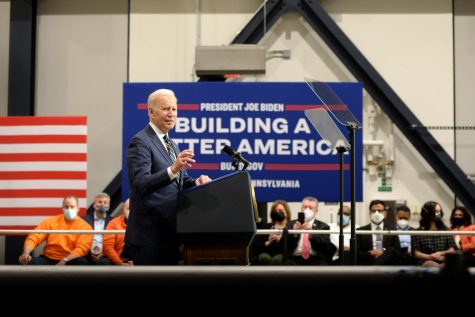An argument for increased national minimum wage
March 24, 2014
Unfortunately for Nigerian princes, there has recently been a different type of chain email circulating the nation’s AOL accounts: a message claiming that President Barack Obama has, to date, signed “1000+” executive orders, which far surpasses the number issued by previous commanders in chief.
Don’t start protesting too quickly, though — it turns out, quite unsurprisingly, that this claim is blatantly false. Not only has the president signed fewer than 200 executive orders, but even the fabricated number pales in comparison to the 3,522 implemented by former President Franklin D. Roosevelt.
That being said, he has been busy as of late closing the gap, with the most recent orders focused on raising the minimum wage.
On Feb. 12 of this year, the president signed an executive order raising the minimum wage offered to federal contractors to $10.10, set to come into effect in 2015. Additionally, in a different form of executive action, Obama issued a memorandum directing Secretary of Labor Thomas Perez to “propose revisions” to existing regulations on overtime pay.
These efforts are all a part of the president’s push to prop up stagnant wages and curb the country’s increasing inequality. The centerpiece of this directive is a proposal to raise the minimum wage to $10.10 across the nation. Unfortunately for Obama, this change must come from Congress, which is not well-known for its expediency or, of late, willingness to work with the executive branch.
However, once again, congressional inaction in this circumstance will prove unwise, as the benefits of enacting such legislation far outweigh the costs.
The Congressional Budget Office recently released a report detailing the projected effects of increasing the minimum wage to both $9.00 and $10.10 (in stages) by 2016, at which point it would be adjusted annually to compensate for inflation.
In short, the CBO found that the “$10.10 option” would increase the earnings of 16.5 million people, leading to an increase of $5 billion in real income for those living below the poverty line, whose ranks would be reduced by 900,000. However, the policy would also lead to a loss of 500,000 jobs. Additionally, the $9.00 option would have similar but reduced effects.
The release of these results caused a stir in Congress and the political sphere, in general, with each side of the aisle taking something different from the report. These commentators generally focus on the immediate costs and benefits of proposed legislation, as the short-term impacts fit the arguments traditionally made by each camp. However, the largest benefit accrues from the long-term impact of a minimum wage indexed to inflation.
But first, we need a little Econ 101: Economists differentiate between what is called the “nominal wage” and the “real wage.”
The nominal wage is the dollar value that a worker is paid for an hour of work — $10.10 in this case. The real wage is the nominal wage divided by the price level of the economy; simply speaking, it represents how much can be purchased with a certain wage. For example, a nominal wage of $10 would correspond to a higher real wage in an economy in which a loaf of bread costs $1 as opposed to an economy in which the same loaf costs $10.
Clearly, the real wage is a much better indicator of what a worker is paid. Now if the minimum wage is adjusted for inflation, defined as the annual increase in prices, the real wage will (theoretically) remain constant. This will have two distinct positive impacts.
First, it will prevent the real erosion of the minimum wage. In the past, while the nominal minimum wage has remained constant, the real wage has steadily decreased as inflation ate away at the value of $7.25 per hour. This will both improve the well-being of those receiving the minimum wage and curb inequality.
Second, this will prevent the adverse impact on employment that results from sudden, large changes in the minimum wage, such as that proposed by Obama. Returning to Econ 101 for a moment, suppose that the minimum wage is increased in line with a general increase in prices. Employers may be forced to pay their employees more, but they will also have an increase in revenue, as the price of their products will have increased, and workers will be able to afford them, as their wages will have risen.
Thus, each year will see a consistent real minimum wage with minimal variations in employment. This stands in stark contrast with the status quo in which the government periodically increases the real wage substantially, resulting in a loss of jobs from both a rising black line and the economic shock from a sudden change in input prices.
Now regardless of the long-term benefits, attention still must be paid to the short-term impact of this policy.
The main question is whether or not the increase in national income would justify the loss of 500,000 jobs. Commentators from the left have responded by questioning the methodology of the study, claiming that if the CBO had stayed more true to the literature, the projected impact on employment would have been lessened.
This may be the case, however, it’s hard to imagine a situation so rosy that a 39 percent increase in the minimum wage doesn’t cause a marked decrease in employment.
That being said, this doesn’t mean that this policy shouldn’t be passed; rather, Congress should enact further legislation to compensate those who have lost their jobs. This could come in a variety of forms, including extending unemployment benefits or providing federal assistance to “retool” workers who have been out of the labor force for an extended period of time.
The legislation has the nation’s support, it’s just a matter of congressional action at this point. Perhaps a chain email through the House of Representatives about the merits of an increase in the minimum wage might improve congressional resolve.
Write Thomas at [email protected].







